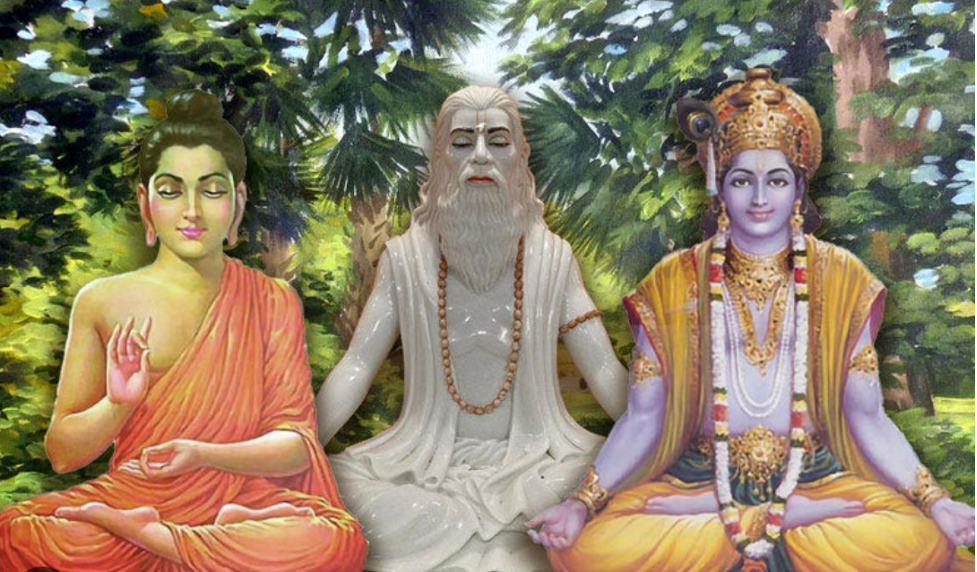I will always be grateful to one of my clients who brought me into the realm of Buddhist teachings. Although I had formally studied Buddhism in college, my spiritual studies have been primarily Hindu or ‘yoga’ based. But in 2018 I dove into the deep end of Tibetan Buddhist teachings practices, and have loved reflecting on where these different facets of the jewel of dharma meet.
I state it this way because of one for Buddhism’s 59 Lojong slogans which states, “All dharma agrees at one point.” In yoga, I was given the teaching of seeing all spiritual teachings as light shining through a prism casting different shades of the same light. Some of us are born into (well, that’s another post for the future) or drawn to yellow, others to blue. Different paths, same destination. And the destination for Hindus, yogis and Buddhists is enlightenment via the path called dharma.
So what happens when someone who has been on the path of yoga dharma meets Buddha dharma? Comparison. The yogic mind asks, “What is the same and what is different? How and where do the dharmas agree? Only at the top, with the widest lens? And can I have a bigger vision where both can be lovingly held?” Well, the answer is “Easy, especially from my western trained mind – it’s easy to see how both eastern paths intersect as at first they appear to be very different from my western roots. But as one of my teachers always said, “Ask, ‘what is the difference a difference makes’?” In other words, can I see both similarities and differences and hold and appreciate both paths, where they come together and where they diverge, and see the strengths of each?
This drsthi, this view or facet is what yoga trained me in – what difference a difference makes and honoring both. For example, in the body, your gluteus maximus and your popliteus are booth muscles. The first being the largest muscle in the body, and the second being a very small muscle, but both being crucial for the health of the knee. Can I see them as the same in this way, and revere each for what it does differently? This is one of the main benefits of yoga. To cultivate this vision – one light, luminously shining through different colors, different powers. It is a horizontal paradigm first, and then also seeing the difference.
Most often, the first teaching taught in Buddhism is that what is the same in all sentient beings is that we want to be happy, and that we all suffer. In Yoga the first teaching I was taught was “See god in each other.” Every sentient being. Equal first. Equal to god, equal to others. Can you cultivate that vision?
Just like the thousands of myths, legends, epics, koans, parables, underneath each traditions favorites, striking similarities can be found. In the same way the only reason I can teach you about how to use your quadraceps is because all quadraceps work in the same way. Mine are both different and the same as yours at the same time.
So at a deeper level, different stories from different spiritual traditions may have different colors, may have different clothing, but we can look under the surface to see the equality. Equality does not appear on the surface. Difference is on the surface. Can we have the vision to go inside to see the sameness? Can we cultivate the vision to see the clear light that illumines all colors?
This is useful in our daily lives when we are dealing with people, especially difficult people. Do the exercise of asking yourself what is the same about me and this person. If we all do have the same light shining through us, but I cannot see that, how do I change my perspective? And also ask what are our differences? And what difference do those differences make?
Here’s an example. I am having solar panels installed. Before the job was finished and inspections done, the salesman asked me to pay him in full. My first reaction was protective. I did not think it wise to pay in full for an incomplete job. I told him so, but he insisted that the job was done and I was being unreasonable.
I had the paperwork that stated the inspection was not done. I shared it with him and declined his insistence that I pay. I could sympathize with him that he wanted to be happy by completing the job, getting his commission check – we shared that, a desire to be happy, but we had differing ways on going about that. It did take a shift in my vision, I did have ask myself, “OK, how can I keep my heart open to this person?” But with this question I was able to sharpen discernment at the same time as have an open heart. It is possible to hold 2 differing things together at the same time. Embracing Buddhist teachings while on a yogic path is a great way to increase a peaceful heart and serene mind – and isn’t that what we all want?

